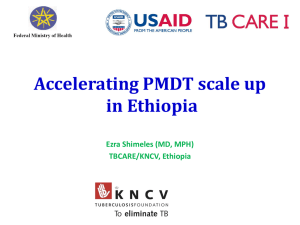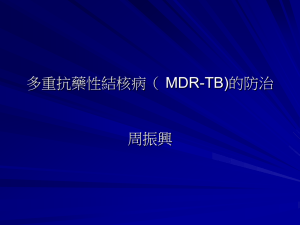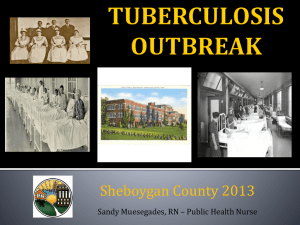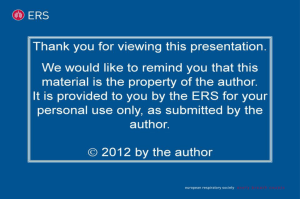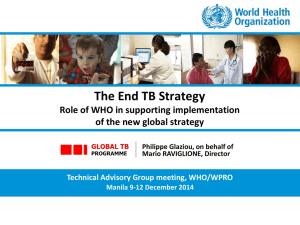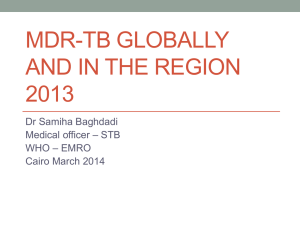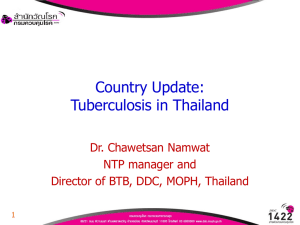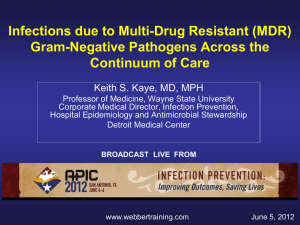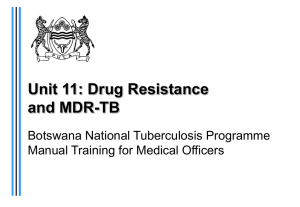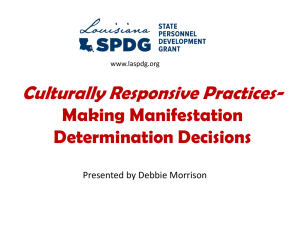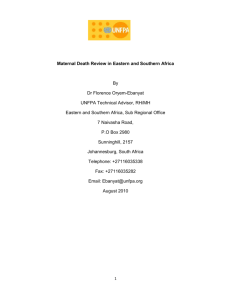DIAGNOSIS OF TB DISEASE Do`s and Don`ts What happens if you
advertisement
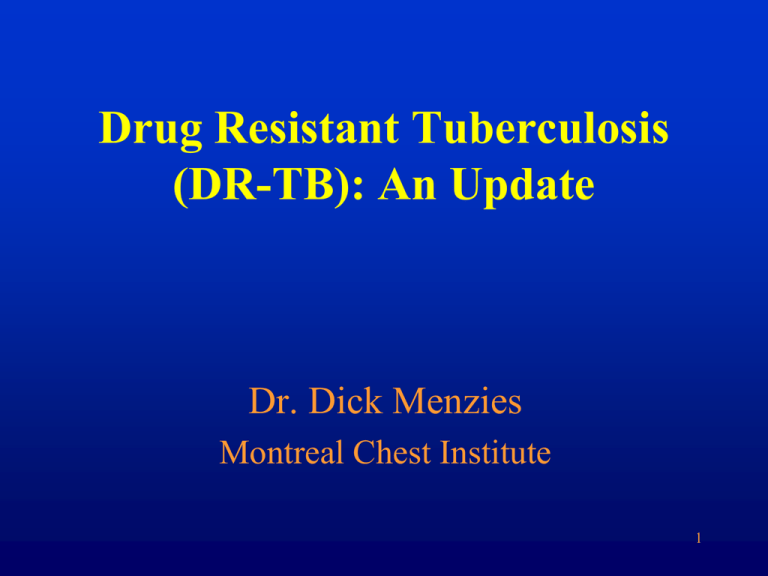
Drug Resistant Tuberculosis (DR-TB): An Update Dr. Dick Menzies Montreal Chest Institute 1 Definitions – Primary DR: Resistance in person treated <1 month or not at all – Acquired DR: Resistance in person treated > 1 month – Mono-drug resistance: Resistance to 1 drug – Poly-drug resistance: Resistance to >1 drug, but not MDR. – MDR: resistant to isoniazid and rifampin – XDR: MDR & resistance to Quinolones & Injectable 4 Epidemiology of DR-TB summary • Global total in new cases: 17% – 3% MDR and 0.5% XDR – 14% other forms (INH most common) • Highest in Former Soviet Union – And certain Latin American countries – Increasing in China, India, S Africa • Low in Canada – mostly seen in immigrants from these high risk regions 6 Global TB Estimates All forms of TB Greatest number of cases in Asia; greatest rates per capita in Africa Multidrug-resistant TB (MDR-TB) Extensively drugresistant TB (XDR-TB) Estimated number of cases Estimated number of deaths 9.23 million 1.7 million 489,000 120,000 (5.3%) 40,000 (0.5%) Adapted from a slide provided by Dr. Paul Nunn, WHO Geneva 20,000 Proportion with MDR-TB in new and previously treated cases, 1994-2007 MDR in New patients Previously treated patients Trends in Global Drug Resistance in New Cases (AZIZ, Lancet 2006) High Income Canada Any Resistance MDR USA Any Resistance MDR United Kingdom Any Resistance MDR 1994 - 96 2001 – 02 10% 0.8% 9% 0.7% 12% 1.6% 13% 1.1% 7% 1.1% 8% 0.9% Trends in Global Drug Resistance in New Cases (AZIZ, Lancet 2006) 1994 - 96 2001 – 02 Any Resistance 34% 32% MDR 14% 12% Any Resistance 29% 37% MDR 7% 14% Middle Income Latvia Russia (Tomsk) How does drug resistance develop? (aka Pathogenesis) Treatment with Streptomycin alone, or PAS alone % Patients with resistance - Days after Tx started Source: Rieder, Interventions for TB control, IUATLD. Treating TB with one drug – Improvement then worsening – the fall and rise phenomenon Source: Toman Case Finding and Chemotherapy Rate of spontaneous mutations of M Tuberculosis to anti-TB drugs Streptomycin 10-6 Isoniazid 10-6 - 10-7 Rifampin 10-8 - 10-9 Ethambutol 10-7 - 10-8 INH&Rif 10-14 19 Total number of bacilli – by clinical extent of disease Lesion Quantity AFB Granuloma 103 Latent Infiltrates 106- - 107 Negative Cavity 108 - 109 + , ++ Many cavities, 1010 - 1012 +++ Death 1013 too late! Probability of developing resistance during therapy – by number of drugs Number of Drugs Total number of bacilli 104 106 108 1010 1012 One 1% 63% 100% 100% 100% Two 0 0 .01% 1% 60% Three 0 0 0 0 0 22 Transient drug resistance during therapy with two or more drugs (effect of default) 23 From Toman, Case Finding and Chemotherapy Association of MDR-TB and regulation of TB drugs • Ecologic survey of 100 countries – Mostly low-middle income countries • Significant correlation of poor regulations of TB drug sales and MDR in new cases – Sales in private pharmacies – Dispensing/prescription by private MDs rather than TB programme 25 Ecologic study: MDR and Tx outcomes • 161 – reported treatment outcomes to WHO in 2003 and 2004 • 121 – Had > 250 cases annually • 118 - Initial MDR prevalence - (WHO) • 103 – Used standard Tx schemes (GDF) – 78 WHO Initial regimen (6 months RIF) – 27 Union Initial regimen (2 months RIF) Failure rate with standardized Retreatment in 103 countries – by prevalence of Initial MDR 25 20 15 10 5 0 Failure of Retreatment - Total <1% 1-2% Failure Initial, Then Retreatment 2-3% >3% Diagnosis of drug resistance (very briefly) Diagnosis of DR-TB • Old methods – proportional on solid media – Slow – 4-8 weeks for culture • Another 4-8 weeks for sub-cultures for DST – Relatively inexpensive – so used in low-income • Current methods – Indirect in liquid media – Faster but more expensive – Still 2-4 weeks for culture – Then another 2-4 weeks for DST 30 Microscopically Observed Drug Susceptibility (MODS) • Direct inoculation of specimens – for detection & DST • Microscopic colony detection • Average time to results: 9 to 11 days • Excellent sensitivity and specificity • Low costs - materials & equipment • Labour intensive www.modsperu.org Newest and fastest: Molecular tests – Line probe assays Detection of MTB & INH & RIF-resistance Requires extraction, amplification Colorimetric development using immobilized probes Excellent sensitivity and specificity – Lower for INH (more mutations) – But limited field studies – Still potential for contamination • Expensive ($50-60 per test) 34 Accuracy of Line Probe assays (from Ling et al, Thorax, 2010) Sensitivity Specificity 35 Cepheid GeneXpert MTB/RIF Boehme et al. 2010 NEJM • Automated RT-PCR • Simple 1-step specimen preparation • Minimal biohazard risks • Results in 2 HOURS!! • Demonstration studies (6673 patients, 6 sites): • Sensitivity for diagnosis 99% in smear + 80% in smear - / culture + • Rifampicin resistance 95% sensitive 98% specific Treatment of DR-TB INH Mono-resistance Other forms of non-MDR resistance MDR-TB How good is the published evidence? One last thing …. How good is the published evidence? • Trials of retreatment – N = 4, all published before 1980 • Trials of INH resistant patients – N = 5, also older studies • Trials of current standardized retreatment – NONE • Phase 3 Trials of MDR treatment – NONE Isoniazid resistance (excluding MDR) Global weighted mean, 1994-2007* • 7.4% in new cases • 12.4% in previously treated Treatment • Dogma: “INH-R is of little importance”. Treat with standard therapy • Evidence – two systematic reviews – New cases – some of whom had INH-R – Studies of INH-R or retreatment • Risk of failure & acquiring MDR-TB 42 Treatment Failure in New cases If Initial Drug Resistance Systematic review of 57 studies with 20,000 patients. Initial Drug Resistance Arms (N) Events/ Subjects Event rate (95% CI) 121/15117 0.3% (0.1, 0.4) Pan-Sensitive 127 INH resistant 68 26/483 3.0% (0.7, 5.3) Streptomycin Resistant 54 6/316 1.3% (0, 2.8 Poly-drug resistance 42 41/287 8.4% (2.1, 14.7) Initial Drug Resistance and Treatment outcomes (from Meta-regression) Systematic review of 57 studies with 20,000 patients. Initial Drug resistance Failure Relapse IRR (95% CI) IRR (95% CI) Acquired drug resistance IRR (95% CI) Pan-Sensitive 1.0 (reference) 1.0 (reference) 1.0(reference) INH resistant 9.8 (7.2, 13.7) 2.2 (1.7, 30) 6.3 (4.1, 9.5) Streptomycin Resistant 6.4 (3.9, 10.2) 2.0 (1.4, 2.8) 7.0 (4.3, 11.6) 28 (19, 40) 2.2 (1.5, 3.2) 12.9 (8.3, 20) Poly-drug resistance Cohort Studies with Mono-resistance to INH Standardized WHO Re-treatment (2HRZES/1HRZE/5HRE) Total Number Treated Number (%) who Failed 39 7 (18%) 31 6 (19%) 18 8 (44%) Intermittent therapy and Treatment outcomes - INH resistance (from multivariate meta-regression) Failure IRR (95% CI) Relapse IRR (95% CI) Acquired drug resistance IRR (95% CI) Daily Initially 1.0 (reference) 1.0(reference) 1.0(reference) 3X weekly thru-out 3.0 (2.0, 4.5) 1.5 (0.9, 2.5) 2.4 (1.4, 4.2) 2X weekly thru-out 2.4 (1.6, 3.5) 4.5 (1.9, 10.7) 1.5 (0.9, 2.5) Number of drugs in initial phase to which strains sensitive - INH resistance (from multivariate meta-regression) Number of Drugs Failure Relapse IRR (95% CI) IRR (95% CI) 6.8 (1.3, 36) Acquired drug resistance IRR (95% CI) 1 10.0 (3.9, 28) No obs. 2 5.0 (2.4, 11.0) 4.6 (1.7, 12.2) 60 (4.0, 99) 3 3.1 (1.5, 6.7) 3.8 (1.5, 10.0) 27 (1.7, 99) 4 1.0 (reference) 1.0 (reference) 1.0 (reference) My take – therapy of INH-R • Dogma wrong • Treat with fluoro-quinolone through-out – Two studies (CDC, and Russia) show that FQ equal to INH – can replace in regimen • Avoid intermittent therapy – at least initial 2 months • Give 4 effective drugs in first 2 months • Duration?: Longer=safer 49 Other forms of DR-TB - therapy • If mono-RIF resistance: – INH/PZA/FQuin/EMB/Injectable – 2-6 mos • Then INH/EMB & FQuin – total 18 mos • If PZA resistance: – INH/RIF/EMB – 2 mos, INH/RIF – 7 mos • If EMB resistance: – Can ignore (its rare though) • If Strep resistance: – Can ignore (usually not tested) 50 Multi-Drug resistance - therapy • Long and difficult • Second line drugs – more toxic, and less effective • Optimal therapy controversial 51 Rational selection of MDR-TB regimen Group 1 Isoniazid Ethambutol Rifampin Pyrazinamide Group 2 Streptomycin Kanamycin Amikacin Capreomycin Group 3 Ofloxacin Moxifloxacin Group 4 Group 5 Levofloxacin Gatifloxacin Ethionamide Prothionamide Cycloserine Terizidone Thioacetazone P-aminosalicylic acid Clofazimine Imipenem Amoxacillin/Clavulanate 52 Macrolides Linezolid Individual Patient Data (IPD) meta-analysis of patients with Multi-drug Resistant Tuberculosis Preliminary results Dick Menzies, on behalf of: The IPD in MDR Group The Collaborative Group for Meta-Analysis of Individual Patient Data in MDR-TB (members in alphabetic order) D. Ashkin, S.Ahuja, M. Avendano, M. Bauer, M. Becerra, A. Benedetti, M. Burgos, R. Centis, E. Chan, C.Y. Chiang, F. Cobelens, H. Cox, E. Declercq, D. Enarson, D. Falzon, K. Flanagan, J. Flood, J. Furin, L. Garcia-Garcia, N. Gandhi, P. Hopewell, T. Holtz, S. Keshavjee, WJ.Koh, V. Leimane, C.C. Leung, J. Li, A.K. Maug, D. Menzies, G.B. Migliori, C.Mitnick, S.S. Munsiff, M. Narita, E. Nathanson, P. O’Riordan, M. Pai, D. Palmero, G. Pasvol, J. Pena, C. Perez, MID Quelapio, H.T. Quy, A. Ponce-de-Leon, V. Riekstina, J. Robert, S. Royce, M. Salim, H.S. Schaaf, K.J. Seung, L. Shah, K.P. Shean, T.S. Shim, S.S. Shin, Y. Shiraishi, Jose Sifuentes-Osornio, G. Sotgiu, M. Strand, P. Tabarsi, T.E. Tupasi, M. Vargas, M. Van der Walt, T.S. Van der Werf, A. Van Deun, P. Viiklepp, W.W. Yew, J.J. Yim Research Objectives • “Which are the most (and least) effective drugs for MDR TB treatment?” • “What is the optimal number of drugs?” – Intensive phase – Continuation phase • “What is the optimal duration of treatment?” – Initial intensive phase (duration of injectable) – Total duration Study Selection • 3 systematic reviews of MDR treatment: • Johnston et. al. (2009) • Orenstein et. al. (2009) • Akçakir et. al. (2010) • Inclusion criteria of these 3 reviews: – Original data, published since 1970 – Bacteriological confirmation of INH- and RIF-resistant TB – Excluded if strictly XDR-TB patients • IPD eligibility – Investigators willing and able to share their data – At least 25 MDR cases – Treatment and treatment success known Meta-analysis Methods • Random effects logistic regression to obtain the odds ratio of treatment success for each drug – Models included a random intercept & random slope – Estimate OR for each study, then pool estimates • Multivariate approach controlled for: – gender – age at MDR TB diagnosis – HIV – disease severity (AFB smear/CXR cavities) – past TB treatment (none, previous TB treatment, previous MDR TB treatment) 3 Systematic reviews identified – Orenstein, Johnston, Akcakir Figure 1. Study Selection 93 studies identified from 3 systematic reviews Excluded: 26 publications representing the same or overlapping cohorts 67 individual cohorts 32 data sets included, with 9898 patients 9153 patients analyzed Excluded - 35 cohorts 13 – No author response 8 – No longer have access to data 5 – Inadequate outcome data 2 – Refusals 2 – No response following initial contact 2 – No data on drug sensitivity testing 2 – Data never sent 1 – Cohort with less than 25 patients Excluded Patients 410 - XDR TB 127 - Extra-pulmonary TB 208 - No treatment info Treatment Outcomes N = 9,153 patients • • • • Cure/complete (success) - 4932 (54%) Failure/relapsed - 732 (8%) Death - 1392 (15%) Default - 2097 (23%) Draft WHO Recommendations for new MDR treatment guidelines(1) 1. Use rapid DST testing for resistance to INH and RIF or RIF alone at the time of diagnosis of TB over conventional testing or no testing 2. Use smear and culture over smear alone for monitoring 3. Use fluoroquinolones 4. Higher generation FQN > lower generation 5. Use ethionamide / prothionamide Draft WHO Recommendations for new MDR treatment guidelines(2) 6. Initial phase with 4 SLD TB drugs likely to be effective (including inj.) and Z 7. Regimen with FQ, Km, Eto/Pto, Cs or PAS, plus Z 8. Initial phase at least 8 months, total treatment of 21-24 months 9. ART in all HIV/MDR-TB patients 10. Use mainly ambulatory care rather than mainly hospital care Conclusions • DR-TB treatment is more complex, usually longer, and should be daily • DST essential to guide therapy • Evidence base for therapy of DR-TB is very weak – ‘expert’ opinion usually. – Hence strong differences in opinion • New drugs and RCT needed 63 Acknowledgements • Systematic Reviews – Woojin Lew, Olivia Oxlade, Madhu Pai, Faiz Khan • Ecologic studies: Anita Paydar, Anton Mak • IPD meta-analysis: Melissa Bauer, Maria Holmes-Delgado, Sandra Ramoutar, Lena Shah, • Slides (with some edits) from: – Kitty Lambregts, Fuad Myrzayev, Matteo Zignol, Sarah Royce, Jessica Minion, Madhu Pai, Thank you! Merci! Gracias!! References • Akçakir Y. Correlates of treatment outcomes of MultidrugResistant Tuberculosis (MDR-TB): a systematic review and meta-analysis. Montreal: McGill University; 2010. • Johnston JC, Shahidi NC, Sadatsafavi M, Fitzgerald JM. Treatment outcomes of multidrug-resistant tuberculosis: a systematic review and meta-analysis. PLOS One 2009;4(9). • Orenstein EW, Basu S, Shah NS et al. Treatment outcomes among patients with multidrug-resistant tuberculosis: systematic review and meta-analysis. Lancet Infect Dis 2009;9(3). • 2008 Emergency Update from WHO
